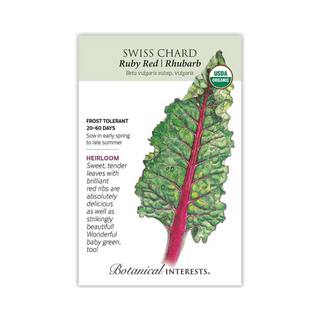
Description
Ruby Red' chard will beautify your garden as well as your plate! An 1850s vigorous grower with a long growing season, it will provide fresh greens from early summer into fall, and year-round in mild climates. Packed with vitamins and minerals, young leaves are great for salads. Any size leaves can be steamed, stir-fried, added to lasagna, omelets, soups, and stews, and mixed with other greens. Good container variety.
Variety Info
- Days to Maturity: 50–60 days
- Family: Amaranthaceae
- Native: Mediterranean region, Europe
- Hardiness: Biennial; fairly cold tolerant. Will overwinter in mild climates and withstand light to moderate freezes.
- Exposure: Full sun to part shade
- Plant Dimensions: 24" tall, 18" wide
- Variety Info: Dark green crinkled leaves with red veins and stalks and sometimes with reddish coloring in the leaves.
- Attributes: Frost Tolerant, Good for Containers
Sowing Info
- When to Sow Outside: RECOMMENDED. 2 to 4 weeks before your average last frost date, and when soil temperature is at least 40°F, ideally 75°–90°F. Sow as late as 2 months before first fall frost. Mild Climates: Sow in fall.
- When to Start Inside: 4 to 6 weeks before transplanting out, 2 to 4 weeks before your average last frost date (protect from heavy freezes).
- Days to Emerge: 5–10 days
- Seed Depth: ½"
- Seed Spacing: A group of 2 seeds every 8"
- Row Spacing: 18"
- Thinning: When ½" tall, thin to 1 every 8"
Growing Info
- Harvesting: Pick up to 1/3 of the outer leaves as needed, and let more leaves grow from the center of the plant; or, if desired, harvest the whole plant 2" above ground, and it will grow back. Pick very young leaves, at 2"-4" for using fresh in salads.
Description
Ruby Red' chard will beautify your garden as well as your plate! An 1850s vigorous grower with a long growing season, it will provide fresh greens from early summer into fall, and year-round in mild climates. Packed with vitamins and minerals, young leaves are great for salads. Any size leaves can be steamed, stir-fried, added to lasagna, omelets, soups, and stews, and mixed with other greens. Good container variety.
Variety Info
- Days to Maturity: 50–60 days
- Family: Amaranthaceae
- Native: Mediterranean region, Europe
- Hardiness: Biennial; fairly cold tolerant. Will overwinter in mild climates and withstand light to moderate freezes.
- Exposure: Full sun to part shade
- Plant Dimensions: 24" tall, 18" wide
- Variety Info: Dark green crinkled leaves with red veins and stalks and sometimes with reddish coloring in the leaves.
- Attributes: Frost Tolerant, Good for Containers
Sowing Info
- When to Sow Outside: RECOMMENDED. 2 to 4 weeks before your average last frost date, and when soil temperature is at least 40°F, ideally 75°–90°F. Sow as late as 2 months before first fall frost. Mild Climates: Sow in fall.
- When to Start Inside: 4 to 6 weeks before transplanting out, 2 to 4 weeks before your average last frost date (protect from heavy freezes).
- Days to Emerge: 5–10 days
- Seed Depth: ½"
- Seed Spacing: A group of 2 seeds every 8"
- Row Spacing: 18"
- Thinning: When ½" tall, thin to 1 every 8"
Growing Info
- Harvesting: Pick up to 1/3 of the outer leaves as needed, and let more leaves grow from the center of the plant; or, if desired, harvest the whole plant 2" above ground, and it will grow back. Pick very young leaves, at 2"-4" for using fresh in salads.

